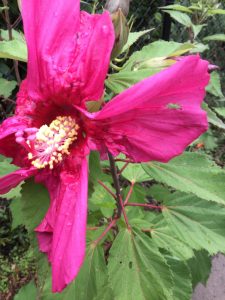
I have outdoor hibiscus for 30 years in Guelph, in the last 10 years I noticed infection of black spots on the red hibiscus and the flower is deformed. I asked several horticulture specialists and used all their advices, but did not work .
The infection appears on the flowers every summer, that means the roots are infected. Any advice? Please help.
Please find attached photos of these flowers. (2 Attachment
Thank you for contacting the Toronto Master Gardeners concerning your hibiscus.
Perennial hibiscus, Hibiscus moscheutos are prone to leaf spots and various fungal diseases. You mention that you noticed black spots on your hibiscus, were these spots on the leaves?
Symptoms of leaf spot vary depending on the strain of fungus infecting your plant, but generally appear as discoloured, irregular spots on foliage. Any fallen leaves should be removed as soon s possible to prevent the spread of the fungus. Do not compost these leaves, instead put them in your regular garbage.
Are the leaves of your hibiscus distorted? Do you see stem dieback? Leaf drop? If this is the case it could be that your hibiscus is suffering from bacterial blight. Are the flowers of your hibiscus discoloured or spotted? Then it is possible that your hibiscus is suffering from botrytis blight. Pruning the diseased branches and providing the hibiscus with good airflow helps to control both bacterial and botrytis blight.
Another possibility for your deformed flowers are Japanese Beetles. Japanese beetles lay their eggs in the soil under lawns.The larvae will overwinter in the soil and continue feeding as the weather warms in the spring. Once the larvae are full grown, they will pupate and emerge as adults in late June and early July. The adult beetle will continue to feed on foliage and flowers through July and August.
We have been hearing a lot from gardeners about this problem. Here is a reply that was posted from our website a short time ago on the same topic:
“This is a common question posted at this time of year. The Ontario Ministry of Agriculture and Food has a website at the bottom of which there is a lists of plants that are most susceptible to damage by this insect. To control Japanese beetles you can either control the adult or the larvae. the best method (although still time consuming but strangely satisfying) is to go out in the early morning or in the late evening when they are not as likely to fly around and simply knock them into a small bucket/jar of water (add a few drops of soap) where they drown. You will need to begin this process at the end of June or the beginning of July and continue until sometime in early August. After that, the next method of control is to go after the larva. Nematodes are best applied in August and are watered into the affected area. They attack the larva of Japanese beetle, June bugs and European chafer all of which racoons and skunks like to dig up the lawn in search of. When applying nematodes it is important to keep them refrigerated until you are ready to apply them. Ideally they should be applied on an overcast morning or evening. If the lawn is dry it should be irrigated first with about ½ to 1 inch of water. You should prepare and use the entire pack and water (while agitating) them into the soil. You might need to irrigate the lawn again to “wash” the nematodes into the soil. You can also reference our other responses to this problem at Roses and Grey Grubs in the Lawn“

